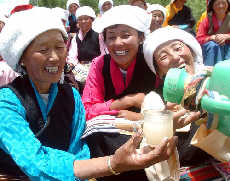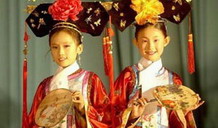Harvest Festival
 The Harvest Festival is celebrated at the end of the seventh Tibetan month just before peasants begin to reap their crops. This is usually in September of the Gregorian calendar.
The Harvest Festival is celebrated at the end of the seventh Tibetan month just before peasants begin to reap their crops. This is usually in September of the Gregorian calendar.
The Harvest Festival is commonly known as the "Onkor Festival," or Wang-guo Festival in Chinese. "Onkor" is a translation of the Tibetan word meaning "looking around the fields." According to agronomic needs, specific dates for the Festival vary according to locations.
As one of the most popular and busy festivals in rural areas, the holiday is one Tibetan farmers, looking forward to preparing for their harvests. It is usually celebrated when crops are ripe, and lasts for three to five days.
During the festival, some people put on ancient warrior dresses, riding on horses decked out in fancy colors as they trot through the fields. They are met by people holding barley plants, colorful flags with good wishes, Buddha's images, and carrying a "harvest tower" made of barley stalks and ears. They sing and dance, beat drums and gongs and walk around the fields. People also enjoy horseracing and contests. It is only after these rites that they will begin the intense autumn harvest.
It is said that the festival has enjoyed a history of more than 1,500 years. According to Tibetan documents, aqueducts were constructed in the Yalong area toward the end of 500 AD, and people began to use wooden plows and agricultural production became more developed. In order to ensure a plentiful harvest, the Tibetan King asked the hierarchy of Bon religion for guidance. Following the tenets of that faith, peasants walked around their fields, beseeching the Heavens for a good harvest, the origin of the Onkor.
the Tibetan King asked the hierarchy of Bon religion for guidance. Following the tenets of that faith, peasants walked around their fields, beseeching the Heavens for a good harvest, the origin of the Onkor.
But the Onkor was not a formal festival at that time, only an activity before taking in the crops. After the rise ofBuddhism, the ceremony changed to its present form, tinged with features of the newer religion.
The best places to catch this festival are in rural Tibet, includingLhasa, Gyangtse, Shannan, and other locations.






